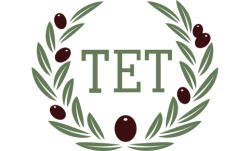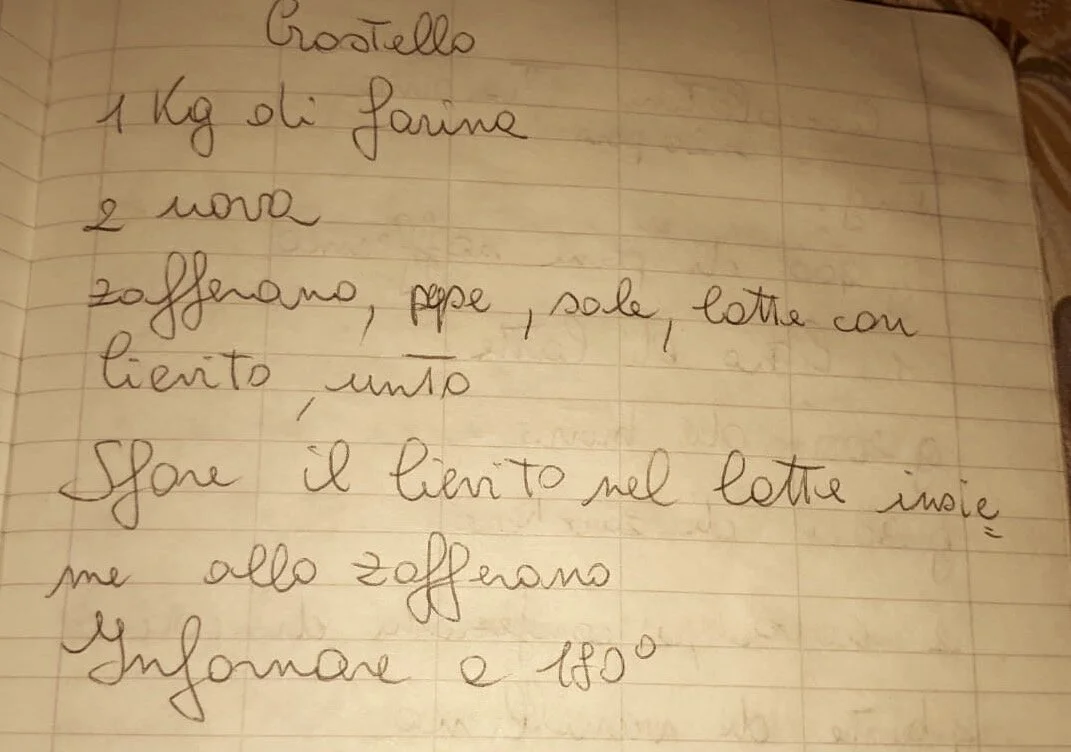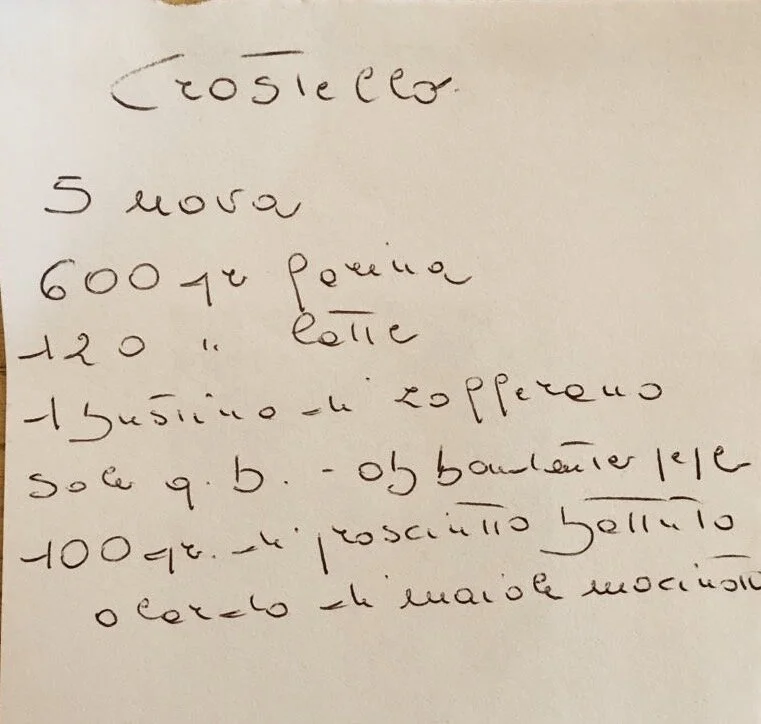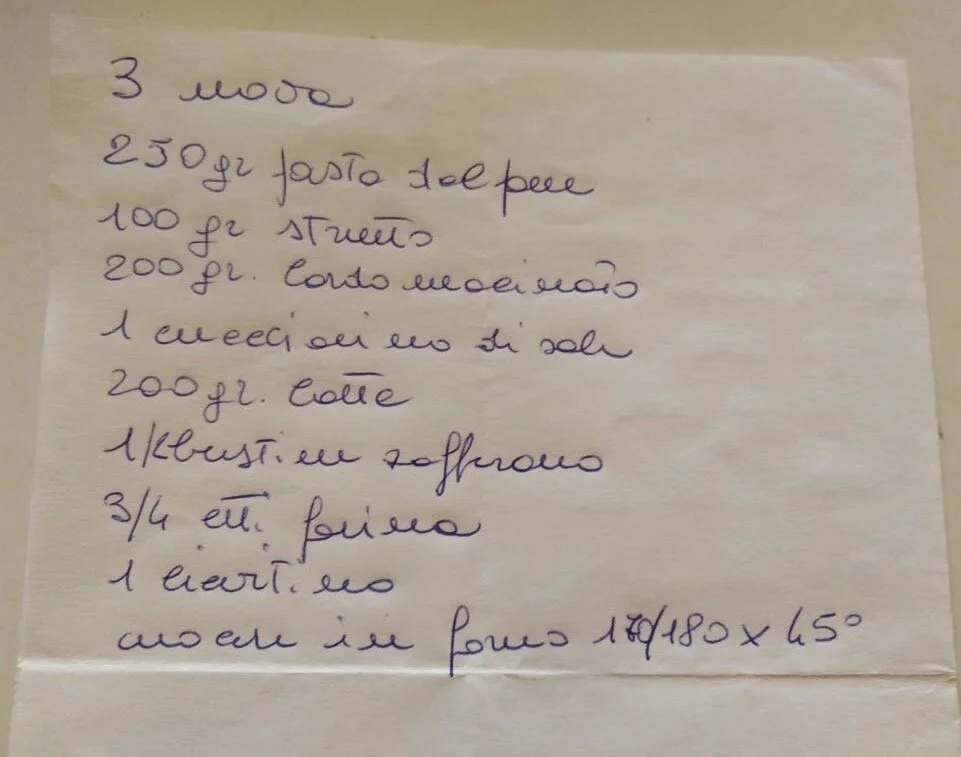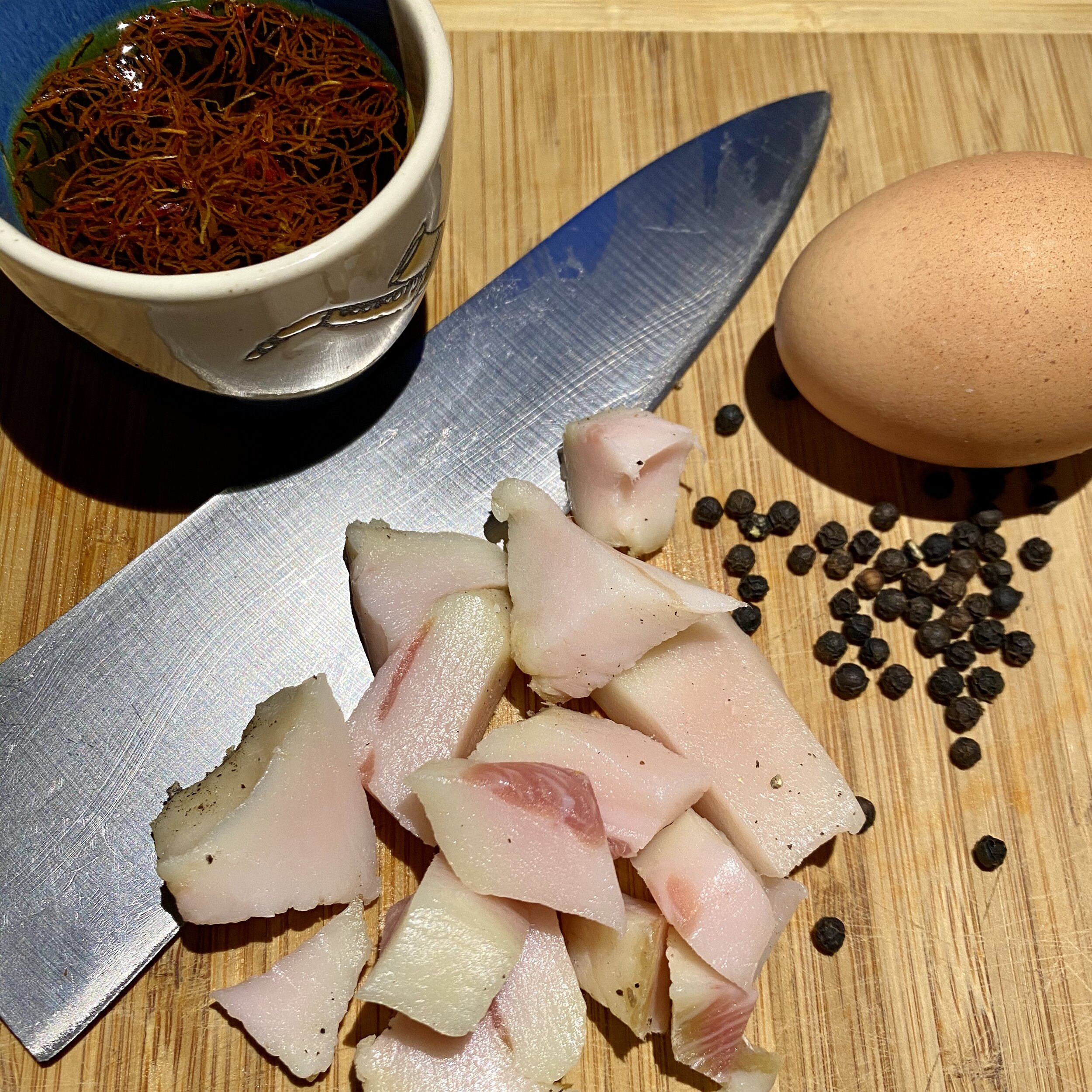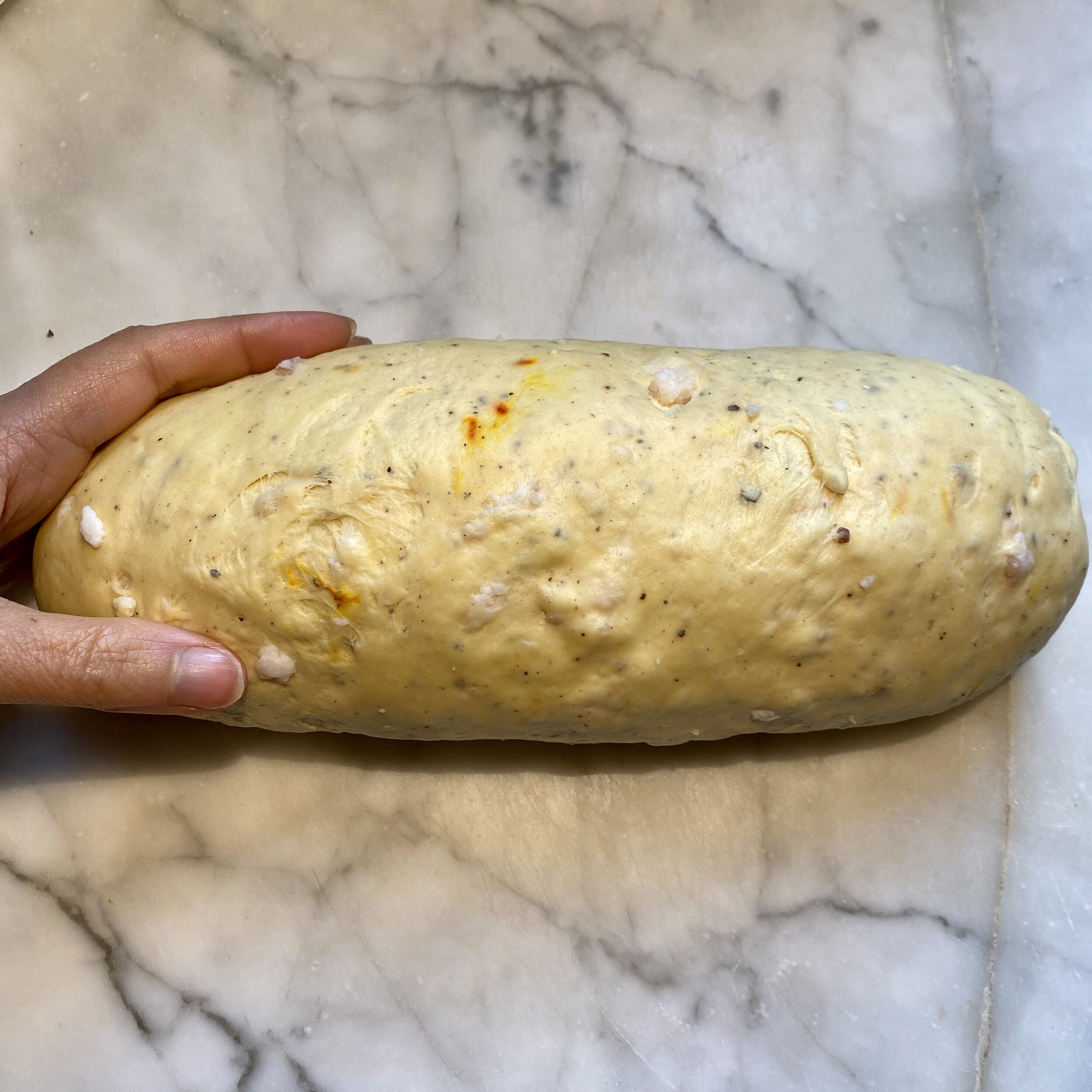It is April 2020. Here in Italy we are all going to be spending Easter in lockdown. This prompted me to investigate an Easter bread that is an exclusive culinary tradition of the town I live in, Città di Castello.
The bread is called crostello. It is enriched with lardo (cured pork fat) and egg, distinctly seasoned with pepper and lightly scented with saffron. The effect is a golden bread that satisfies like meat, a reward for the faithful after 40-days of mortification of the flesh through self-abnegation.
There are a few bakeries, or rather, few bakeries in and around town that still make crostello at Easter time. Not being a native, and having hitherto only eaten bakery crostello, I had always wondered what the fascination was. It was dry, the pepper was the lackluster powdered stuff, and it seemed to have been made with lard (rendered pork fat) rather than lardo, which is altogether different. The mouthfeel was both greasy and dry at the same time. More often than not, it got tucked under the side of my plate until I could secretly toss it out.
Still, I wanted to look into it. I wanted to see if the story behind this bread was as rich as the fat content. And I wanted to see what it tasted like when baked with care.
Saving crostello - The journey
My mission started with the history, to which end I contacted Marino Marini, head of the local chapter of Slow Food and a native of Castello. He told me that some time back he had spent some time looking into the antecedents of this bread in an effort to link it to the ancient Roman crostacea (or crostulum?) but to no avail. I too set out on a virtual dig through antiquity. It took me down numerous fascinating rabbit holes but yielded not a single lead.
I then called local historian Alvaro Tacchini, a walking repository of the history of the Valtiberina, the upper Tiber river valley of which Città di Castello is a part. Alas, culinary history is not his milieu and he knew nothing about the legacy of crostello. “Ask me anything about wars, politics, the economy. As for food, I’d be hard pressed to boil water.”
Bread. Who do I know who knows about bread?
Surely, Franco Palermo, venerated bread guru of Rome, would be able to give me a lead. Franco is a man of few words, unless he is talking about bread, which is pretty much all he does talk about. But even though Rome is just a two-hour drive from Città di Castello, crostello is such a small town tradition that even he had never even heard of it.
Empty handed, I turned my attention to symbolism. Surely the egg, wine, and the yellow coloring of the bread meant something. Eggs are an important symbol of new beginnings, even the Easter bunny is hip to that. And what about wine and the Eucharist? Pretty symbolic bringing that together with bread - the blood and the body of Christ (even though the wine is white…) all in one go? Spiritual economics. The saffron imbued a golden color, and, hey, isn’t the New Jerusalem supposed to be made of gold (Rev. 21:18, 21)?
I consulted Andrew McGowan, a specialist in Early Christianity and particularly learned on the subject of bread. But rather than getting swept up in the whirlwind of my enthusiasm, he cautioned about me rushing into facile interpretations of symbolism. He said that perhaps I need look no further than my original, more prosaic idea of crostello being a satisfying, meaty bread with the enticing aroma of peppered pork - reason enough for this bread to become an Easter tradition - a fitting celebratory food to cap the long period of fasting.
The promise of Zion faded as quickly as it arose, so I left well enough alone and moved on to the practical part.
A Fading Heritage
The usurper: torta di pasqua.
As a traditional Easter bread, crostello has been completely upstaged by the torta di pasqua - a capricious cheese bread shaped like panettone. Though it is not nearly as difficult make as panettone, it is the non plus ultra of Umbrian baking. Who makes it better than whom is a lively topic of conversation throughout Holy Week.
On Easter morning, the customary Castellano breakfast is crostello and the cheesy torta ( pane) and local salumi, cheese, and boiled eggs (blessed that morning by the priest) as the accompaniments (companatico). It’s definitely a joyous “Fahoo fores dahoo dores,” moment.
Oddly, when I went online to do comparative research, only one recipe surfaced for crostello. There weren’t even any images. Generally, everyone wants to get their two cents in on a traditional recipe, from old signoras to Top Chefs. Despite my misgivings, I was saddened to realize that I was witnessing a fading tradition - crostello was teetering on extinction. I rolled up my sleeves and went ahead modifying the one recipe I had found online. In the meantime, I got the word out in town about my mission.
I managed to round up three other hand written recipes that sentimentalists had conserved, but they were quite bare bones, each one different from the last and, unlike the recipe online, none contained wine. So much for my Eucharist theory.
Rescuing traditions
The house filled with the glorious smell of baked bread… with a distinct aroma of pork and pepper. The true test was to send out trial samples (all in accordance with the lockdown regulations) to some old signoras who were of an age and disposition to not mince words. I waited for their call, and the response was overwhelming.
The taste-testers said that this bread had transported them back in time. The flavor rekindled their memories the crostello of their youth, with a well-structured crumb that met the demands of the traditional deli meats. They implored me to pass it on to as many people as possible to keep the tradition alive.
I am honored to be making that contribution to Città di Castello. Closer to Easter I will be making crostello again and tweaking it with a couple of the suggestions from the recipes above.
I’ll let you know. ;-)
Città di Castello in lockdown, April 2020
Crostello
ingredients:
[pre-ferments]
Bowl 1: 80g 100% hydration sourdough starter + 40g water + 40 bread flour
Bowl 2: 80g high extraction (high gluten) flour (also called W400) + 1/4 tsp dry active yeast + 80g water
Mix, cover each bowl with a plate, leave for a few hours to rise until very bubbly.
(If you want to skip this part, just use a total of 600g of flour, 1/2 packet of dry instant yeast and add 100ml water and another 100ml of milk to the liquid total below)
[dough]
400g bread flour (W360)
1 good pinch saffron threads
80ml white wine (or warm milk)
2 eggs
80g lardo, or prosciutto/guanciale fat, or non-smoked cured bacon fat - chopped
1/2 tbsp salt
1/2 - 1 tsp freshly ground black pepper
a piece of pork rind with fat on it (cotenna) optional
Instructions:
Put the saffron in the wine and rub it between your fingers to color the wine.
Run the fat through whatever small food processor you have so that it becomes a creamy mass with discernible bits as shown below.
Put the pre-ferments and egg into a standing mixer with a dough hook and mix until combined.
Add half of the flour with the machine running together with the wine and saffron.
Add the fat and leave the machine run until combined.
Mix the salt and pepper with the remaining flour and add to the rest of the dough.
Mix until combined and then put out onto a counter and knead for five minutes. It should be easy to knead and quickly feel smooth and elastic.
Put this is a covered container and refrigerate overnight for the slow bulk rise.
[shaping]
The next day pull your dough out into a square. Fold the upper corners in slightly and bring the top edge down halfway pushing it down firmly. Tuck the bottom corners up and roll the dough over so that the seam is down. Rock it back and forth a couple times for good measure.
Place the log onto a piece of parchment paper. With your bread stone in place, put the dough loaf into the oven.
Take a shallow bowl and pour a cup of boiling water in it (you can do this operation in the microwave). Place the bowl of water in the lower part of the oven so that the steam will warm the oven and keep the dough moist.
After about two and a half hours it should double in size and give a bit when you press on it.
After shaping, before rise.
doubled in size
Heat the oven to 250°C. Let it keep heating for 20 minutes even if it arrives at the temperature before that.
Prepare four ice cubes (unless you have some other means of doing this), and prepare to slide your dough (on the parchment) into the oven. If you don’t have a peel you can use a flat cookie sheet.
Place the bread on the stone, throw the cubes into the bottom of the oven, close the door and turn the heat down to 220°C.
After 20 minutes, turn the bread, tent it with a piece of foil and turn the heat down to 180°C for another 20 minutes.
Loosely tent the bread at halftime.
If you want to do the optional special touch, heat up your fatty pork rind so that it is greasy and run it over the loaf after the second cooking. Likewise you could just brush it with olive oil or even leave this step.
Bake another 5 minutes untented.
Let cool completely on a rack. Yes, I know. It will be very tempting, but it’s best not to cut into it as the quality of the crumb depends on it cooling completely.
Resist the temptation to cut into it before it has cooled. Just let go.
Serve with high quality salumi, cheese and boiled eggs the morning of Easter - or whenever you want.
Traditional Easter breakfast in Città di Castello, Umbria.
